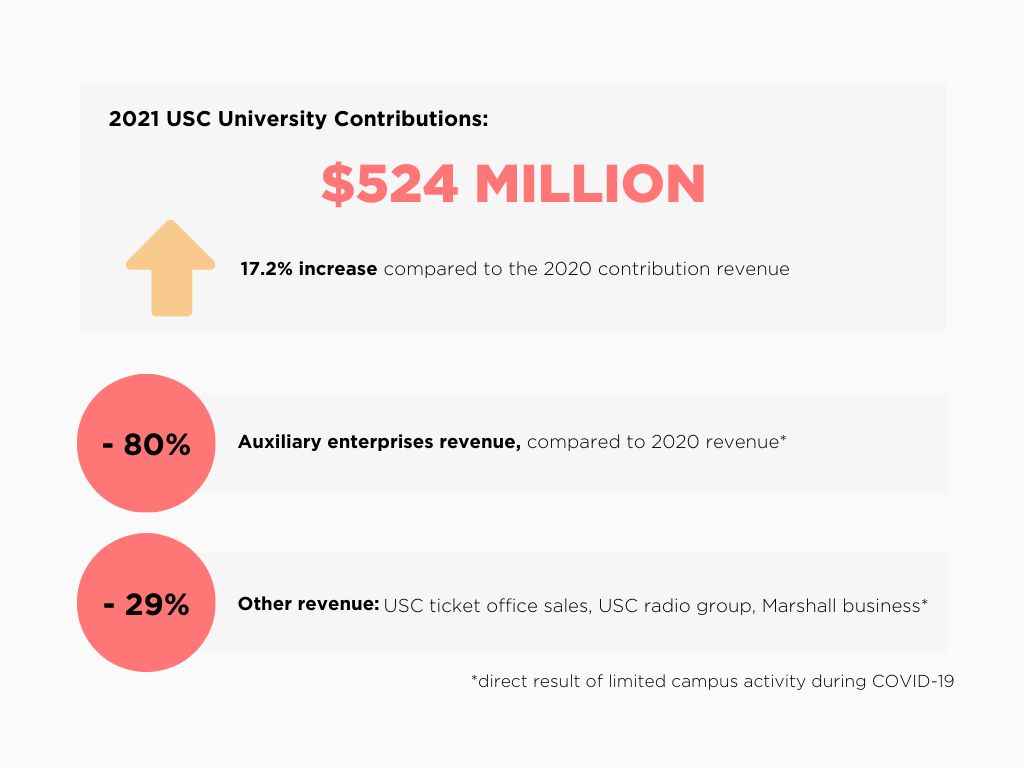Tuition, government funding and endowment rise from latest financial report

The June release of the newest USC financial report revealed varying statistics about University finances, with tuition prices rising and the coronavirus pandemic affecting revenue streams.
For the University’s 21,000 undergraduate students, the price of tuition increased by 2.1 percent, resulting in an annual cost of attendance of $79,063. Of those who were in the 2020 entering class, 21% received a merit-based USC scholarship, and two-thirds received some form of financial assistance.
Jessica Bukowski, a sophomore majoring in communication, said that she was “amazed” to see the high-priced tuition rise each year with how few freshmen were receiving merit scholarships compared with how many were receiving assistance.
“[For] a school that’s as competitive as USC to get into already, I feel like 21% is still a very low number considering how many of these students are very academically high achieving,” Bukowski said. “I think it’s crazy how a lot of these students, even with getting these merit scholarships to help tuition, still have to seek other aid … You shouldn’t have to pay that much for an education.”
James Nguyen, a sophomore studying cognitive science and English, said that the increasing price of tuition was difficult to deal with, even with picking up multiple jobs during the summer to support the cost.
“I’m not shy to say that I’m in need of financial aid … so [the school] increasing it even more really hurts me,” said Nguyen.
According to the University’s comptroller Erik Brink this overall cost of attendance comprises four major parts: tuition and fees, room and board, miscellaneous expenses and books. The increase in price reflects updates in financial aid packaging, as well as compensates for the latest averages of housing in the local Los Angeles area.
“Not every student lives in a University housing facility, so [the financial aid office] tried to factor in what that cost is in our community,” said Brink.
The school additionally plans to maintain its need-blind admissions policy for future USC admits.

Another significant factor at play within the unique financial statistics from this year’s report is the effect of the coronavirus pandemic on revenues, general campus maintenance and spending on physical capital. Auxiliary revenue, including revenue from the USC Village, Athletics, and events held at the Los Angeles Memorial Coliseum decreased by 80 percent. Other revenue from USC Ticket Office sales, the USC radio group and Marshall business decreased by 29 percent. Meanwhile, health care services revenue increased by 11.4 percent — and clocks in as the largest revenue stream for the university.
“All of that was impacted really significantly by the lack of us being on campus,” said Brink. “We hope to, over the next year, get back to that level that we were at before.”
Additionally, USC received a total of 103 million dollars in federal COVID relief funding due to the passage of the CARES Act, which provides higher education grant funds to support universities during the pandemic. 56 million dollars was given directly to students through aid packages, while the remaining funds were used to support the University during the period of time when students were off campus and out of dorms.
The net assets of the USC endowment now total 8.126 billion dollars — a 37 percent increase from the previous year; investments in the school’s endowment, including venture capital programs, returned at a high percentage of 43.2 percent.
University contributions and gifts also rose at around 17 percent (a total of $524 million) in the 2021 fiscal year, but this was due to the timing of recognition of new construction plans.
“We have a really good track record of keeping a stable gift program coming in. For fiscal year ‘21, there was some recognition of some gifts relative to some construction projects that just happened to come through during that year, and so gave it a little extra increase,” Brink said.
Brink expects the next fiscal year’s report to be published around late spring.

